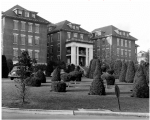Difference between revisions of "Portal:Featured Article Of The Week"
M-Explorer (talk | contribs) |
M-Explorer (talk | contribs) |
||
| (29 intermediate revisions by the same user not shown) | |||
| Line 1: | Line 1: | ||
{{FAformat | {{FAformat | ||
| − | |Title= | + | |Title= Riverview Hospital |
| − | |Image= | + | |Image= coquit2.png |
|Width= 150px | |Width= 150px | ||
| − | |Body= | + | |Body= In 1872, Royal Hospital in Victoria was converted to British Columbia's first facility to house mentally ill patients. Due to overcrowding, Royal Hospital was closed and the patients moved to the new Provincial Asylum for the Insane in 1878. Again facing problems of overcrowding at the turn of the century, in 1904 the provincial government purchased 1,000 acres in then-rural Coquitlam for the construction of Riverview Hospital and the adjacent Colony Farm lands. |
| + | |||
| + | Patients were originally housed in temporary buildings, and in 1913 the building that would eventually be called West Lawn began treating the 300 most seriously ill male patients. By this time, Colony Farm was producing over 700 tons of crops and 20,000 gallons of milk in a year, using mostly patient labor. British Columbia's first Provincial Botanist, John Davidson, established an arboretum, nursery and a botanical garden on the hospital lands, often with the assistance of patients as there was a belief in the therapeutic value.[3] The botanical garden was moved to the new University of British Columbia in 1916, but the arboretum and nursery remained. | ||
| + | |||
| + | In 1924, the Acute Psychopathic Unit, later called Centre Lawn, opened. Then in 1930, the 675-bed Female Chronic Unit (later called East Lawn) opened. The first phase of what would eventually be called the Crease Clinic, the Veteran's Unit opened in 1934, with the second phase opened in 1949, giving Riverview its most iconic building. Finally in 1955, the Tuberculosis Unit (now called North Lawn) opened, marking the peak of patient residence. [[Riverview Hospital|Click here for more...]] | ||
}} | }} | ||
Revision as of 04:33, 8 December 2019
Featured Article Of The Week
Riverview Hospital
In 1872, Royal Hospital in Victoria was converted to British Columbia's first facility to house mentally ill patients. Due to overcrowding, Royal Hospital was closed and the patients moved to the new Provincial Asylum for the Insane in 1878. Again facing problems of overcrowding at the turn of the century, in 1904 the provincial government purchased 1,000 acres in then-rural Coquitlam for the construction of Riverview Hospital and the adjacent Colony Farm lands.
Patients were originally housed in temporary buildings, and in 1913 the building that would eventually be called West Lawn began treating the 300 most seriously ill male patients. By this time, Colony Farm was producing over 700 tons of crops and 20,000 gallons of milk in a year, using mostly patient labor. British Columbia's first Provincial Botanist, John Davidson, established an arboretum, nursery and a botanical garden on the hospital lands, often with the assistance of patients as there was a belief in the therapeutic value.[3] The botanical garden was moved to the new University of British Columbia in 1916, but the arboretum and nursery remained.
In 1924, the Acute Psychopathic Unit, later called Centre Lawn, opened. Then in 1930, the 675-bed Female Chronic Unit (later called East Lawn) opened. The first phase of what would eventually be called the Crease Clinic, the Veteran's Unit opened in 1934, with the second phase opened in 1949, giving Riverview its most iconic building. Finally in 1955, the Tuberculosis Unit (now called North Lawn) opened, marking the peak of patient residence. Click here for more...
